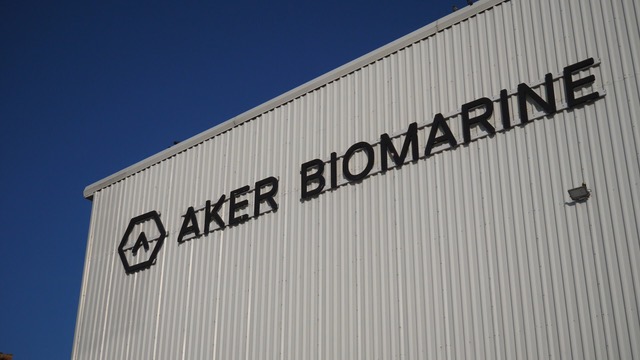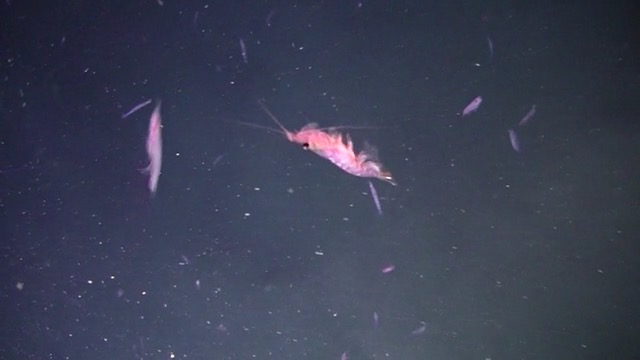Fishing companies are hoping to “double” their catches of krill — tiny animals that sustain the Antarctic Ocean — to feed the fish farming industry.
An international investigation for The Ferret has also discovered that current levels of krill fishing are worrying scientists and environmentalists. They fear impacts on penguins, seals, whales and seabirds.

Antarctic krill (Euphausia superba) are small shrimps, just a few centimetres long. They are a fundamental part of the Antarctic environment, providing food for many other marine animals.
But krill are increasingly being fished by multinational companies to supply food for farmed fish in Scotland and around the world. A rich source of protein, they are also marketed as pet food and as human health supplements.
We travelled to Uruguay and the southern tip of Chile close to the Antarctic to talk to the companies that are fishing krill and the scientists who are studying them. We filmed a giant warehouse piled high with large bags of krill to be sold to fish farming companies and pet food manufacturers.
Krill fishing companies are convinced that their businesses will grow. The Association of Responsible Krill Harvesting Companies (ARK), which brings together eight Norwegian, Chinese, Chilean and South Korean firms, is hoping to be allowed to catch more krill.
ARK’s executive officer, Javier Arata, told us that he expected the krill quota to increase from the current 620,000 tonnes a year. He argued that it could go much higher without harming populations of predators such as penguins and whales.
“I’d venture that maybe the quota will just double that we have, in the good years, but there will also be years with lower catches,” he said.
Arata suggested that an improved monitoring system would identify years when krill were abundant and areas where they could be more intensively fished. Better monitoring could also limit catches when stocks were low.
The Antarctic krill fishery is managed by the Commission for the Conservation of Antarctic Marine Living Resources (CCAMLR), which involves 37 countries. It is part of the international Antarctic Treaty System, formed in 1961 to protect the continent.
CCAMLR set the 620,000-tonne “trigger” limit on krill fishing in 1991, about one per cent of the estimated total of 62m tonnes of krill. So far the limit has never been reached, although catches have been increasing in the last two decades, reaching a record high of 451,000 tons in 2020.
There are currently 12 large krill fishing vessels operating in Antarctica, belonging to seven companies from five countries. Norway and China are by far the biggest producers, followed by Chile, South Korea and Ukraine.

Marketing krill to fish farmers
In July 2022 we visited Montevideo, Uruguay, to see the main logistics centre of Aker Biomarine, which manages about 65 per cent of the world’s Antarctic krill production. It is part of the Norwegian Aker group headed by the billionaire, Kjell Inge Røkke.
Loads of meal produced with krill arrive at Aker’s warehouse after being processed on board vessels trawling the seas around Antarctica. From the warehouse, shipments are exported every day all over the world.
“We have three fishing vessels operating in Antarctica and we have one vessel that is in charge of the transport — the Antarctic Provider. It comes to Montevideo port roughly every 45-60 days,” said Gian Franco Guerrieri, sales manager for Aker Biomarine.
Most of the bags stacked in hundreds of piles in the warehouse are destined to feed farmed fish, while some will be used for pet food. In Houston, Texas, Aker also adds krill to Omega 3 pills supposed to improve human health.
“Eighty per cent of our catch and production on board goes to aquaculture and pet food, but most of it is aquaculture,” said Aker’s aquaculture specialist, Ragnhild Dragøy.
“We sell all over the world and we sell everything we produce. We have markets in Norway, in Chile, in Asia, in Australia, in the US.”
In recent years interest in Antarctic krill from the fish farming industry has risen as companies search for new sources of protein to replace feed ingredients made from wild fish.
According to the United Nations Food and Agriculture Organisation, fish farming is the fastest-growing food industry. It had a global output of 87.5m tonnes in 2020, and was projected to reach 106m tonnes by 2030.
But such growth can cause the overfishing of species used to produce fish meal and oil to feed carnivorous farmed fish such as salmon, trout or sea bream.
“How can we reduce our dependence on marine resources while increasing the amount of farmed fish?” asked Anders Østergaard, sustainability specialist for BioMar, a leading fish feed company that uses Aker Biomarine krill in some products.
“There will be more and more different alternative raw materials for fish feed, and that is due to the fact that we cannot rely on just a few sources of raw materials,” he said. “Especially as marine resources are scarce, limited”.
Studies from Aker Biomarine claim that krill meal can to some extent replace fishmeal and make more efficient use of other protein ingredients, such as insects or soy, particularly for salmon, trout, shrimp and sea bass farms.
“As a fish feed producer we are looking for alternatives to several ingredients that we are using, including fishmeal and fish oil,” said Robert Tillner, product and research manager for the fish feed company, Aller Aqua.
“Krill is one of the ingredients we are also using,” he added. “Mostly in our salmonids feed, so feed for trout and salmon. That’s where we use it”.

Krill fed to salmon farmed in Scotland
The Ferret reported evidence in August that two multinational salmon companies active in Scotland used krill, while another two did not. The campaign group, Changing Markets, argued that krill fishing was depriving penguins, whales and seals of vital nourishment.
But most of the salmon farming companies in Scotland have refused to say anything about krill. The two said to be using it — the Faroese giant, Bakkafrost, and Norwegian-owned Scottish Sea Farms — would not comment.
Cooke Aquaculture, which is believed not to use krill, said it did not respond to “requests from The Ferret”. Mowi confirmed that krill was “not an ingredient used in salmon feed” produced at its plant at Kyleakin on the Isle of Skye.
The krill fishing industry, meanwhile, is planning to expand. Aker Biomarine has set growth targets of up to 60 per cent in its latest corporate presentation. Another Norwegian company, Rimfrost, is set to roll out a new krill vessel in 2022.
The Chinese government has also been providing subsidies to develop krill fishing since 2016. In 2022 a new Chinese trawler is due to be added to the four already operating in Antarctica, and two more Chinese vessels are reportedly under construction.
Russia is also reactivating its interest. The Soviet Union was the first to start industrial-scale fishing for krill in the Antarctic in the 1970s, but this ceased in 2010.
In February 2022 Reuters reported Russian plans to invest 45bn roubles (£638m) in krill fishing, including building five high-tonnage trawlers.

Krill fishing threat to Antarctic
Campaign groups, including Greenpeace, Pew Charitable trusts and the Antarctic and Southern Ocean Coalition, have expressed concerns about the impacts of large-scale krill fishing in the Antarctic Ocean.
Pew’s Nicole Bransome pointed out that krill are consumed by penguins, whales, seals, fish and flying seabirds. “Everybody down there is relying on krill,” she said.
By eating plankton, krill also play a vital role in the oceans’ ability to absorb carbon from the atmosphere and reduce the dangers of climate change, she added.
The krill fishing industry claims that it has so far had no significant impact on krill populations. It points to the results of two surveys conducted in 2000 and 2019 to monitor numbers.
But independent scientists studying the Antarctic ecosystem disagree. In July 2022 we visited the Instituto Antártico Chileno (INACH) in Punta Arenas near the southern tip of Chile, a base for some of the ships that fish for krill in Antarctica.
“There is this inter-annual high variability of the krill biomass, but also there is evidence that this biomass is decreasing through time, meaning that even in the periods of higher biomass, it’s lower than it was in the past,” said INACH researcher, Lucas Kruger.
A study published in September 2022 by Universidad de Concepción and other Chilean research institutes predicted that by 2100 the krill population would suffer “a marked decline” because of climate change.
“After the Arctic, the Antarctic peninsula is one of the areas of the planet that is warming at a faster rate than any other place on earth,” another INACH researcher, César Cárdenas, told The Ferret.
The warming is reducing the habitat for krill and other species, he said. “Distribution of krill has been changing in the last 50-60 years, so now it’s migrating to the south, to colder waters, and this is projected to increase in the future,” he added.
Cárdenas and Kruger both believe that recent growth in krill fishing has put pressure on krill populations, especially near the Antarctic peninsula. “With decreases in sea ice there is more time for the fishing fleet to spend time in the peninsula,” said Cárdenas.
“That’s our concern in terms of potential effects on the predators that depend on krill.”
Kruger published a study in 2020 on the effects of krill fishing on penguin populations. “In the northern part of the Antarctic peninsula Pygoscelis penguin populations are decreasing,” he said.
“The biomass of krill in the northern part of the Antarctic peninsula is also suffering changes, local decreases, changes in the main distribution. So there is less krill available.”
Cover photo thanks to Francesco De Augustinis
This story is part of a series on krill and was developed with the support of journalismfund.eu and Internews’ Earth Journalism Network.
Additional reporting by Rob Edwards.
















I don’t think it is made clear in this article – what percent of the global krill catch is used in feed for Scottish salmon, given you make this particular sector your focus?